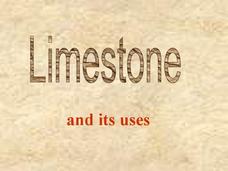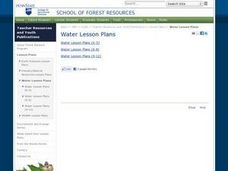Curated OER
"What If The Earth Were Made Of Sand
Students examine the most common characteristics of clay and sand, and to understand how the properties of these materials affect the erosion of the landscape and the formation of the many landforms. They explore clay and sand through...
Curated OER
Limestone and Its Uses
Everything you ever wanted to know about limestone fills these 15 slides. Its properties, uses, and reactions with other materials are all explained. Most likely, this would be useful in a high school geology class as an example of...
Curated OER
Acids and Bases
In this acids and bases worksheet, students compare the properties of acids and bases. Students determine the concentrations required to neutralize solutions. This worksheet has 1 word problem and 14 multiple choice questions.
Mr. E. Science
Sound
Since light travels faster than sound, some people may appear bright until you hear them speak. The presentation covers what sound is, how fast it travels in various mediums, properties of sound, hearing, and the parts of the human ear.
Curated OER
Alcohols, Phenols, and Ethers
Twelve pages of text tells viewers about the physical properties and naming procedures for alcohols and ethers. A page is also dedicated to briefly describing phenols. This straightforward chemistry presentation comes to you as a PDF...
Curated OER
Acids and Alkalis
This PowerPoint progresses slide-by-slide through all the facts you would want to deliver about acids, alkalis, salts, and the related lab tests. Each slide has one or two facts about a physical or chemical property or behavior. The...
Curated OER
Marine Fisheries Management
Almost 200 slides make this a vast collection! It is a quirky collection, titled "Marine Fisheries Management," but having little to do with that occupation. What you will find are two-toned blue backgrounds with no pictures, but a few...
Curated OER
Wildlife
The centerpiece of this lesson plan is a predator-prey simulation in which colored paperclips represent different species of animals camouflaged against a colored background. Relevant follow-up questions are provided. The activity is...
Curated OER
Rain Formation
First graders investigate the different water formations by conducting an experiment. In this water properties lesson, 1st graders examine jars filled with ice, rain water, air and snow in their class. Students predict what will happen...
Curated OER
Our Keystone FFA Spring
Students identify where their water sources and explore a watershed on a map. For this watershed lesson students walk a wetland, and identify sources of pollution.
Curated OER
Describing the Physical World
In this physical world worksheet, students review concepts relating to the chemical and physical properties of matter, density of matter, and if matter is a solid, liquid, or gas. This worksheet has 9 terms in a word puzzle, 4 true or...
Curated OER
Water, Water Everywhere, and Nary a Drop to Drink!
Students sing the continent song and locate oceans between the continents on a map. They read "They Earth is Mostly Ocean" and copy notes into their journals. They watch a demonstration of water and saltwater evaporated to see what is...
Curated OER
"Pennsylvania Watersheds, Many Ways to the Sea"
Students trace a molecule of water through the water cycle including each of its three loops. They describe why evapotranspiration demands the largest portion of total precipitation falling on a forested watershed.
Curated OER
Density and Mass
Learners experiment to find which liquids are more dense. In this density and mass activity, students predict and then test objects to observe and measure their density. learners observe which items sink and float. Students complete...
Curated OER
Things Are Heating Up
In this science instructional activity, students read about chemical changes. Students also answer 3 comprehension questions about the reading.
Curated OER
Solids, Liquids and Gases - Part 2
Students experiment with balloons, soda water and raisins to find out about the states of matter. In this solids, liquids and gases instructional activity, students complete a group activity with balloons to recognize the state of...
Curated OER
pH and Red Cabbage Juice
Students review properties of materials and define what pH tells them about matter. In this pH levels lesson, students determine whether materials are acids or bases using indicator substances.
Curated OER
The Effects of Storms
An excellent way to review a chapter or unit on storms, this worksheet features vocabulary review (gust, evacuation, storm surge, salinity), concept review (effects and details about hurricanes), skills/process review (normal high tide...
Curated OER
Pacific Salmon and Mountain Pine Beetle
Learners compare fish anatomy. In this teacher demonstrated dissection lesson, students compare fish anatomy to that of humans. They explore different fish and their unique properties. There are 4 distinct activities which can be...
Curated OER
Icebergs Ahead!
Students examine icebergs and how they are suspended in water, why ice floats, the melting process of an iceberg, and the floating behavior of ice compared to that of a cork through a lab activity.
Curated OER
Be a Watershed - Create a Living River
Students investigate water ways by conducting an experiment with classmates. In this natural resources lesson, students define a watershed and identify where large ones are located within the United States. Students utilize cups,...
Curated OER
Water Wonders
Students measure the amount of surface tension using a balance scale after a classroom demonstration students diagram the appearance of several liquids and label them.
Curated OER
Dry Ice Activities Mini Lesson
Get your middle schoolers experimenting with dry ice. In the first activity, they place a piece in water and then use phenol red to identify its pH. In the second, they place a piece in a limewater solution and watch as the combination...
Cornell University
Unknown Powders
Create a little scientific magic within your classroom! Learners mix powders and liquids and identify chemical reactions. Based on the reactions, individuals determine the identity of various powders.

























